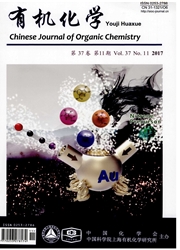

 中文摘要:
中文摘要:
从中国南海的裸鳃目软体动物美丽拟皮片鳃(Dermatobranchus ornatus)中分离得到4个eunicellane 型二萜:Ophirin(1),calicophirin B(2),13-去乙酰氧基calicophirin B(3)及3-去乙酰基.13-去乙酰氧基calicophirin B(4);而由同时、同地采集到的柳珊瑚Muricella sp.中则分离得到calicophirin B(2),13-去乙酰氧基calicophirin B(3),astrogorgin(5)及类似物6.这些化合物的结构经波谱学实验并与文献报道的数据相对照得以确定,并首次对Ophirin(1)的NMR数据进行了全归属.Ophirin(1)的单晶X衍射实验不但进一步确证了化合物的结构,而且使这一类化合物的立体结构表述得到修正.本文是对Dermatobranchus属软体动物化学成分研究的首次报道;研究提示,美丽拟皮片鳃能通过选择适当的食物,并将食物中有用的次生代谢产物转移、富集到身体的特定部位,使之成为自身的化学防性物质.美丽拟皮片鳃与Muricella属柳珊瑚中共同出现的类似化合物支持二者间可能存在的捕食与被捕食的生态学关系.
 英文摘要:
英文摘要:
Four diterpenoids with eunicellane carbon skeleton, namely ophirin (1), calicophirin B (2), 13-deacetoxyl calicophirin B (3) and 13-deacetoxyl-3-deacetyl calicophirin B (4), were isolated from the South China Sea nudibranch Dermatobranchus ornatus, whereas calicophirin B (2), 13-deacetoxyl calicophirin B (3), astrogorgin (5) and an unnamed analogue 6 were obtained from gorgonian Muricella sp., simultaneously collected from the same region as that of D. ornatus. Structures of these compounds 1~6 were elucidated on the basis of detailed spectroscopic analysis and by comparison with those reported data, and a complete ^1H and ^13C NMR assignment of ophirin (1) was carried out for the first time. An X-ray diffraction analysis on a single crystal of ophirin (1) not only confirmed the established structure but also led to a revised stereochemical illustration for the above metabolites. This is the first report of chemical studies on the nudibranch of genus Dermatobranchus, which suggests that Dermatobranchus ornatus can protect themselves from predators by selecting appropriate diet, and consequently transforming and bio-accumulating some useful dietary metabolites into selected body parts as defensive substances. The discovery of similar compounds from both the molluscs and the gorgonian suggests a probable predator and prey relationship between them.
 同期刊论文项目
同期刊论文项目
 同项目期刊论文
同项目期刊论文
 Biscembranoids and their probable biogenetic precursor from the Hainan soft coral Sarcophyton tortuo
Biscembranoids and their probable biogenetic precursor from the Hainan soft coral Sarcophyton tortuo 期刊信息
期刊信息
